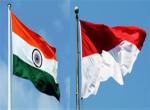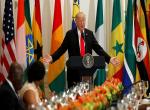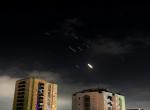Issues Meriting Importance
The People’s Republic of China was established in 1949 under the Chairmanship of Mao Ze Dong. The Peoples Liberation Army (PLA) defeated Generalissimo Jiang Jieshi (Chiang Kai-shek), and formed the government. Thereafter, the Chinese fought three wars on the concept of Peoples War in which mass of soldiers attacked in human waves. It was in their war with Vietnam in 1979, that they realised they needed to change their strategy of fighting wars. This was done under the great visionary leader, Deng Xiaoping.
Deng brought about the four modernisations and also changed the strategy of fighting to ‘Active Defence’. The wakeup call for modernisation came from the First Gulf War in 1991, where 500 new technologies were used. The shock and awe produced by these campaigns stirred the PLA and compelled it to undertake a Revolution in Military Affairs (RMA). The areas which were focussed were on Information Dominance, Long Range Precision Strike, Sensor-to-Shooter Links, Navigation Systems, upgrading the Navy and Air Force and the Second Artillery. The present modernisation has resulted in the PLA graduating to fighting a full spectrum conventional conflict under a nuclear overhang. The priorities for modernisation encompass all the four services but greater priority is being accorded to the Navy, Air Force and the PLA Rocket Force (earlier known as the Second Artillery).
Likely Timelines
The present Chinese Government was formed in 1949. The PLA, which was formed under the Chinese Communist Party (CCP), is an organ of the Party and obeys the Party diktat and has its proportionate representation in various policy committees of the Party. The PLA has actively participated in the Great Leap Forward, the Cultural Revolution and in the modernisation programmes of Deng Xiaoping. Further, it has fought the Korean War from 1950 to 1953, the Sino-Indian War in 1962, the Ussuri River Conflict with Russia in 1969 and the Sino-Vietnamese War of 1979. For about 38 years China has not fought a major war. However, the PLA has been involved in skirmishes on the South China Sea, intrusions in the East China Sea and Tibet, as also in making preparations for a possible military offensive against Taiwan. China has also developed its own defence industry which enables it to indigenously produce state-of-the-art weaponry.
Though Chinese White Papers always state their attitude of being defensive and peaceful, its intentions appear to be deceptive. China’s official media continues to publicise articles intended to caution India that China retains the option of initiating military hostilities. Wen Wei Po, a Hong Kong based daily owned by the People’s Republic of China with editorial staff from the CCP and controlled by the ruling Politburo Standing Committee, published an article in June 2013, captioned ‘Six Wars to be Fought by China in the next 50 Years’. It was re-posted on a Hong Kong web site around middle of September 2013. The details of the author’s background are yet to be ascertained and the contents have been possibly obtained from Chinese defence analysts. The article asserts that China can wipe out past humiliations and regain dignity only after it attains national re-unification. The article visualises that six wars would have to be fought by China in the next 50 years to achieve their goal. The wars visualised are as under:-
- Unification of Taiwan by 2020 to 2025. Need for Anti-Access and Area-Denial capabilities.
- Solution to the disputes in South China Sea between 2025 to 2030.
- Boundary dispute in Tibet by 2035 to 2040.
- Solving the dispute on East China Sea islands between 2040 and 2045.
- Sorting out issues on Outer Mongolia in the period 2045 to 2050.
- Trying to get back the territory earlier lost to Russia between 2050 to 2055.
Major Announcements by Xi Jinping at the 19th Party Congress in October 2018
During the 19th Party Congress, President Xi who is also the General Secretary of the Central Committee of the Communist Party (CPC) of China, delivered a report to the 19th National Congress of the CPC in the Great Hall of the People in Beijing on October 2018. The report lasted for three hours and twenty three minutes. He set a two-stage development plan that will take it to the middle of the 21st century. Strategically, it entailed the following:-
- To achieve socialist modernisation by 2035. At this stage, become a global leader in innovation, have more equal rights for citizens, see improvements in rule of law, increase soft power, improve living standards and create a beautiful China.
- To become a great modern socialist country by 2049, which incidentally happens to be completion of 100 years of establishment of the People’s Republic of China. It implies that China becomes a world player possibly at par or stronger than the United States.
It is interesting to note that according to the Price Waterhouse Coopers Report on the Global and Economic Order Change, China would be having the highest GDP by 2050. This economic rise would naturally be accompanied by greater ambitions. China would thus like to resolve the above mentioned six issues to their advantage by the same time. By 2020 China would like to introduce the latest military reforms where the Central Military Commission and the theatre Commands get stabilised, leading to integration of forces and jointness.
Ability to Attain the Objectives
The focus of China’s modernisation is to ensure that they are able to attain their objectives by deterring their opponents who are subdued and agree to their issues without fighting. Currently China spends about $ 205 billion dollars on its defence budget. It has been assertive in its dealings with India. The unsettled border issue, clandestine supply of nuclear weapons to Pakistan and building the Karakoram highway to connect the Port of Gwadar could trigger Sino-Indian confrontations which could take form of cyber attacks, missile firings, destruction of India’s reconnaissance satellites, use of overwhelming firepower followed by military intrusions to creep and salami-slice territory or even a ground offensive to lower India’s image.
India follows a dissuasive policy against China and a policy of deterrence against Pakistan. In a collusive threat or a two-front war, it would be difficult for India to manage with her current force levels and slow pace of modernisation. There is a need to expedite these issues to be able to face a full-spectrum two-front war by, say 2030 or so. As would be observed from their above mentioned ‘warfare list’, the Chinese are likely to address Arunachal by 2035, accordingly should focus on modernisation of its armed forces.
Wake up Call
India needs to wake up against the threat visualised. China’s military White Papers profess peaceful development in Asia. However, its actions do not match its preaching. The PLA has been undergoing its RMA ever since the end of the First Gulf War in 1991. By 2030, the Chinese Armed Forces would have moved to state-of-the-art weapons with capabilities to militarily secure their claims along the Sino-Indian Border. China is not unduly concerned about international opinion and could undertake military operations which could vary from a full spectrum war to intrusions along with cyber warfare, destruction of satellites and firepower duels including missiles. The Chinese Navy would have also acquired a blue water capability and would use its bases in Pakistan, Sri Lanka, Myanmar, Bangladesh and Maldives to threaten Indian shipping in the Indian Ocean.
The issue at hand is the need for India to respond to the Chinese military capabilities and to deter it from undertaking military aggression. There is a need to analyse the challenge, its implications for India and as to what are the steps necessary to be taken to meet India’s strategic requirements. By 2030, China would have a modern Army, a blue water Navy and an Air Force capable of dominating airspace in the areas of conflict. Developments would also take place in Rocket Forces, Outer Space and Direct Energy weapons.
China’s One Belt One Road would improve its connectivity with its extended neighbourhood. This modernisation is likely to result in greater capabilities which would lead to greater ambitions. Further, China is also becoming assertive in its disputes with Taiwan, Japan, Vietnam, Philippines and India. China is bound to have domestic problems due to slowing down of its economic growth, which could be diverted by external arm twisting in demonstration of its military might against these countries. These have to be responded by the affected countries.
The moot question is: Does China seek a peaceful rise, or is it going to undertake offensive action to occupy the claimed areas? The current trends indicate a rise in assertiveness be it declaration of an Air Defence Identification Zone (ADIZ) or the forcible placement of mobile oil rig near the Paracel Islands resulting in a maritime standoff with Vietnam. China has also been reclaiming land and building airstrips in the South China Sea. India too has undergone numerous border transgressions.
China has stated that the Border Dispute with India will take a long time to resolve. Its military modernisation and weaponising Pakistan pose a direct threat to India. Chinese modernisation enhances its abilities to launch a full spectrum offensive against India. India, being a democracy, needs time to respond to PLA assertiveness but can’t take chances with reading of Chinese intentions. Accordingly, India has to be prepared for a full spectrum conflict by 2030.
A school of thought exists that nuclear weapons negate any major war between India and China. Even then, limited wars and its modern variations cannot be ruled out. In such a case China is likely to use cyber warfare, anti-satellite weapons, missiles, overwhelming firepower and possibly ground offensives comprising multiple intrusions. That possibility calls for India to build its Comprehensive National Power and a strategic response to China by intensification of strategic partnerships with US, Japan, Vietnam, Australia and Russia. Ultimately, there would be a need to modernise India’s armed forces to meet the Chinese challenge. Detailed analysis would enable us to ascertain the issues and thereby chalk out our strategy to meet that end.
Way Ahead
Dealing with China’s modernisation will need a holistic approach to improve our Comprehensive National Power. There are several aspects which need to be taken which are explained below:-
- To face China militarily, overall national development is needed, to include social development, development of human resources and economic development.
- The next aspect is to streamline the national security planning process. This would include the formulation of National Security Strategy, followed by Defence Policy Guidelines, a defence Capability Strategy. Preparation of a Defence Capability Plan would follow with preparation of Long Term Integrated Perspective Plan which leads to a Joint Military Strategy. That would result in Force Structure and modernisation. These steps could be achieved with the help of the Defence Policy Group formed by the Government.
- There is a definite need to improve infrastructure to face the Chinese challenge. This is particularly applicable to the Rest of Arunachal Pradesh (RALPS) where the Border is still to be connected by roads. This has to be viewed particularly in context of the Chinese improvement of infrastructure in this region. Special dispensation must be given for completion of infrastructure projects in the larger interest of national security. There is a need for strengthening Border Roads with other civilian agencies. To dissuade the Chinese, Indian armed forces and their equipment must be in place, and sustained there. Infrastructure must be developed quickly and innovatively. Tunnels must be built to ensure roads are open in all seasons. Underground tunnels must be built under the Brahmaputra River to ensure connectivity with the Rest of Arunachal Pradesh.
- India needs to modernise its armed forces expeditiously through the following steps:-
- Ensure jointness and net work centric conditions.
- Have our Force structure balanced to undertake a two front threat.
- Focus on development of Outer Space for strategic purposes.
- Develop pockets of excellence by focussing on Asymmetric Warfare, Cyber Warfare and Assassin’s Mace Weapons.
- Reorganise our DRDO to focus on cutting edge technologies and allow the private sector a level playing field.
- Be prepared for a limited war under nuclear overhang.
- Create a diplomatic strategy to win war as also the peace.
- Pragmatic dealing with China in the field of trade, building of infrastructure and other areas of cooperation.
Conclusion
India is perceived to be a pacifist nation that is slow in responding to situations. The image needs to be changed across the entire spectrum. A deliberate effort is needed to develop dynamism, proactive approach and offensive mindset in our leadership. Linear thinking should be replaced by a 360 degrees view, shedding conservatism and predictability syndrome. The approach to strategic security should be based on objective assessment and comprehensive strategic response.
(The paper is the author’s individual scholastic articulation. The author certifies that the article/paper is original in content, unpublished and it has not been submitted for publication/web upload elsewhere, and that the facts and figures quoted are duly referenced, as needed, and are believed to be correct). (The paper does not necessarily represent the organisational stance... More >>
Image Source: https://images.tribuneindia.com/cms/gall_content/2015/12/2015_12$largeimg12_Saturday_2015_191032022.jpg











Post new comment